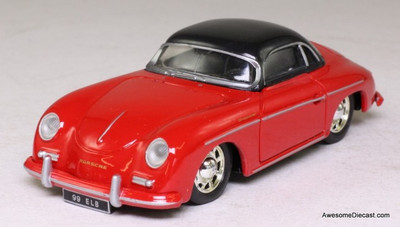
Corgi 1:43 Mercedes 300 SL Convertible, Red
£24.00
The Mercedes-Benz 300 SL (chassis code W 198) was produced from 1954 to 1963. It was first produced as a coupe from 1954 to 1957 with gullwing doors and then from 1957 to 1963 as a roadster. The direct fuel injected production version was based on the company's less powerful carbureted overhead camshaft straight-6 engine 1952 racer, the W194. Mercedes-Benz introduced the 300 SL in February 1954 at the International Motor Sports Show in New York instead of in Europe and was largely the marketing creation of Max Hoffman. It was voted the "sports car of the century" in 1999. The 300 refers to its engine displacement of 300 centiliter or more specifically 2,996 cc (182.8 cu in). SL is the short form for "super-light" in German and refers to the light tubular frame construction
Mass production of the 300 SL was initially not planned. The idea of a toned-down Grand Prix car tailored to affluent performance enthusiasts in the booming post-war American market was suggested by Max Hoffman at a director's meeting in Stuttgart, in 1953. Mercedes' new General Director Fritz Konecke agreed when Hoffman put an order in for 1000 cars and the new 300 SL was introduced at the 1954 New York Auto Show rather than the Frankfurt or Geneva gatherings company models made their usual debuts. In addition, the production of a smaller roadster , the Mercedes-Benz 190 SL was announced after Hoffman put another order in for 1000 of the 190SL's
The two sports cars premiered at the "International Motor Sports Show" in New York, which took place from 6 to 14 February 1954. Mercedes-Benz experienced a very positive visitor response to the 300 SL and the 190 SL at the Motor Show. Serial production began in August 1954 at the Sindelfingen plant. Shortly after the start of production or from the 51st car, the long shift lever, which meshed directly with the transmission, was replaced by a shorter one with a shift linkage.The first W 198 was first sold in Europe in 1954 and in August 1954, the first vehicle was exported to the USA and sold to Briggs Cunningham. Of the 1400 Coupes built in total, the largest part, about 1100, reached the US. More than 80% of the vehicle's total production of approximately 1400 units were sold in the US, making the coupe the first Mercedes-Benz widely successful outside its home market and thoroughly validating Hoffman's prediction. The 300 SL is credited with changing the company's image in America from a manufacturer of solid but staid luxury automobiles to one capable of rendering high-performance sports cars. The 300 SL's main body was steel, with aluminum hood, doors, dashboard and trunk lid. It could also be ordered with an 80 kg (176 lb) saving all-aluminium body but only 29 were made.
Even with the upward opening doors, the 300 SL had an unusually high sill, making entry and exit from the car's cockpit problematic. A steering wheel with a tilt-away column was added to improve driver access.
Initial sales were sluggish due to several things. While initial prices were about $6,800 a new Chevrolet Bel-Air could be purchased for $1,700 in the same year. Then there were few mechanics, even at the dealers, who understood the fuel injection system enough to do repairs. A 1955 Coupe was removed from the showroom to a warehouse as unsellable and was finally sold at dealer cost.












